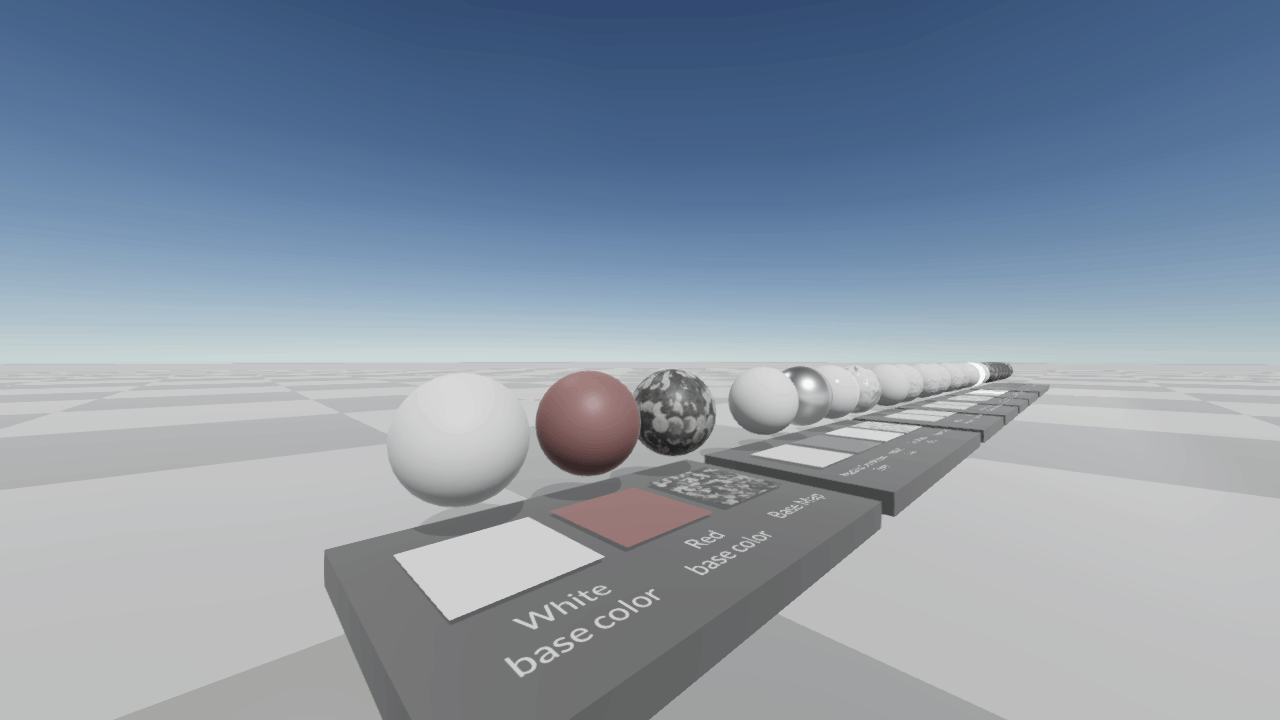👻
UnityのRenderGraphSystem(URP17)に対応した一番シンプルなCustom RPを作ってみる
はじめに
アウトプットが苦手なので練習もかねて、色々書いていこうと思い、記事投稿はじめました。
今回は、Unity2023.3でURPでもRenderGraphを有効化できるようになったので、RenderGraphSysteに対応した、シンプルなScriptableRenderPassの作成をしてみました。
この記事の内容
- URPのOpaquePass描画後に画面効果をかける
ScriptableRenderPass(ScriptableRendererFeature)を作成します・- 執筆時点で、
FullScreenPassRendererFeatureが標準で存在するため、特に作成物自体に意味はないので、そこは流してください。
- 執筆時点で、
- RenderGraph未対応(パッケージ内のコメントに合わせてnon-RG)の場合と、RenderGraph対応(同じくコメントに合わせてRG)の場合の実装両方を記載しています。
この記事で触れないこと
- URP、SRP自体の話。
- GameObject(何かしらRendererを持ったりなどの描画対象になり得る)を描画する場合のRenderGraph対応について(別記事で書くかもです)
- 触れないと言いつつ軽く触れると、
ScriptableRenderContext.DrawRenderersによる描画でなく、RendererListHandleを取得し、CommandBuffer.DrawRendererList(CommandBufferも目的に合わせた種類がいくつか用意されているので、RasterCommandBufferなどを使用)で記述するようになってます。 - RenderGraph同様少し前のバージョンから入っている
- 触れないと言いつつ軽く触れると、
記事で執筆時点での環境
- Unity 2023.3.0b7
- Universal RP 17.0.2
- Core RP 17.0.2
やってみた
使用するシーン
- Uinversal RPパッケージのSampleに含まれるLitシーンを使用します。
- UIだけ非表示にしてます。

- UIだけ非表示にしてます。
今回使用する画面効果のシェーダー
- 最初に画面に効果をかけるシェーダーを用意しておきます。
- シェーダーグラフで、彩度を操作するノード(saturtionノード)を挟むだけのシンプルなものになります。

RendererFeature
- RendererFeatureは従来の実装も、RenderGraph対応後も同様のため以下のものを使用します。
using UnityEngine;
using UnityEngine.Rendering.Universal;
namespace Sample.CustomRP
{
public class CustomRendererFeature : ScriptableRendererFeature
{
[SerializeField] Material blitMaterial;
CustomSamplePass customSamplePass = null;
public override void Create()
{
if (customSamplePass != null) return;
customSamplePass = new CustomSamplePass(RenderPassEvent.AfterRenderingOpaques, "CustomSamplePass", blitMaterial);
}
public override void AddRenderPasses(ScriptableRenderer renderer, ref RenderingData renderingData)
{
renderer.EnqueuePass(customSamplePass);
}
}
}
RenderGraphを使用しない従来の場合のRenderPass
using UnityEngine;
using UnityEngine.Rendering;
using UnityEngine.Rendering.Universal;
using ProfilingScope = UnityEngine.Rendering.ProfilingScope;
namespace Sample.CustomRP
{
public class CustomSamplePass : ScriptableRenderPass
{
readonly Material blitMaterial;
readonly string profilerTag;
public CustomSamplePass(RenderPassEvent renderPassEvent, string profilerTag, Material blitMaterial)
{
this.renderPassEvent = renderPassEvent;
this.profilerTag = profilerTag;
this.profilingSampler = new ProfilingSampler(profilerTag);
this.blitMaterial = blitMaterial;
}
public override void Execute(ScriptableRenderContext context, ref RenderingData renderingData)
{
var commandBuffer = CommandBufferPool.Get(profilerTag);
using (new ProfilingScope(commandBuffer, profilingSampler))
{
// 余談:RenderTargetのSwapまで行ってくれたBlitがObsoleteに……
Blit(commandBuffer, ref renderingData, blitMaterial, 0);
}
context.ExecuteCommandBuffer(commandBuffer);
commandBuffer.Clear();
CommandBufferPool.Release(commandBuffer);
}
}
}
- 実行するとこんな感じに(saturation:0.2にしてます)
- Opaqueで描画されている球体と台座、地面だけ彩度が落とせています。

RenderGraphを使用する場合
using UnityEngine;
using UnityEngine.Rendering;
using UnityEngine.Rendering.RenderGraphModule;
using UnityEngine.Rendering.Universal;
using ProfilingScope = UnityEngine.Rendering.ProfilingScope;
namespace Sample.CustomRP
{
public class CustomSamplePass : ScriptableRenderPass
{
readonly Material blitMaterial;
readonly string profilerTag;
public CustomSamplePass(RenderPassEvent renderPassEvent, string profilerTag, Material blitMaterial)
{
this.renderPassEvent = renderPassEvent;
this.profilerTag = profilerTag;
profilingSampler = new ProfilingSampler(profilerTag);
this.blitMaterial = blitMaterial;
}
// Passで使うデータを定義しておく
internal class PassData
{
internal TextureHandle sourceHandle;
internal TextureHandle tempCopy;
internal Material material;
}
public override void RecordRenderGraph(RenderGraph renderGraph, ContextContainer frameData)
{
// RenderingDataでなく、ContextContainerから自分で必要なデータを撮るようになった
UniversalCameraData cameraData = frameData.Get<UniversalCameraData>();
// IRenderGraphBuilderを使用して構築します
// PassのないようによってRasterPassやUnsafePassなどを選択
// 今回はUnsafePassで追加
using (var builder = renderGraph.AddUnsafePass<PassData>(profilerTag, out var passData))
{
UniversalResourceData resourceData = frameData.Get<UniversalResourceData>();
passData.material = blitMaterial;
passData.sourceHandle = resourceData.activeColorTexture;
// 今回は、CamearaのRenderTargetと同様のおのが欲しいので
// RenderTargetDescripterからTextureHandleを作るものを使用した
var desc = cameraData.cameraTargetDescriptor;
desc.depthBufferBits = 0;
passData.tempCopy = UniversalRenderer.CreateRenderGraphTexture(renderGraph, desc, "_tempCopy", true);
// 他にも
// builder.CreateTransientTexture(in TextureDesc desc);
// で、builderで作成する
// renderGraph.ImportTexture(RTHandle rt);
// などのRTHandleから作成する方法もある。外部管理してるRTHandle使う場合などはこちらのパターン
// Pass中で使用する場合に宣言しておく
builder.UseTexture(passData.tempCopy);
// Passをかリングしないように設定
builder.AllowPassCulling(false);
builder.AllowGlobalStateModification(true);
// UnsafePassの実行を関数を設定します(つまり旧来のExecuteで呼び出していたPassの描画周り)
builder.SetRenderFunc((PassData data, UnsafeGraphContext context) =>
{
using (new ProfilingScope(context.cmd, profilingSampler))
{
// Blitter.BlitCameraTextureが通常のCommandBufferを引数としているため用意されてるHelperで変換
// builder作成するときに、renderGraph.AddRenderPassを使用すれば、変換は不要だが、builder.UseTextureなどは使えない
var commandBuffer = CommandBufferHelpers.GetNativeCommandBuffer(context.cmd);
// RenderGraphではターゲットのSwap操作どうするのが良いのだろう?
// 一旦sourceをcopy
Blitter.BlitCameraTexture(commandBuffer, data.sourceHandle, data.tempCopy);
// Blit
Blitter.BlitCameraTexture(commandBuffer, data.tempCopy, data.sourceHandle, data.material, 0);
}
});
}
}
}
}
-
RenderGraphを有効化する必要があり、ProjectSettings>Graphics>URPのRender Graph Settings>Compatibility Mode (Render Graph Disabled)のチェックを外します。

-
実行結果は同様になると思います。

次の記事
所感
- まだ触り始めで慣れてない+旧来からの置き換え類などを全て把握できていない段階ですが、non-RGとRGでかなりの変更が入っているので、追うのが大変なので、こんなのあるぜ系を自分も教えて欲しいです。
RenderGraphに載せておけば、描画リソース(RenderTextureなど)の管理や、Pass自体の管理を自動で最適化してくてるようになるらしいので、恩恵をフルに受けられるように深掘りしていきたいと思うので、続きの記事も書くかと思います(今はまだ諸事情により書けないですが、作ってるゲームで実際にどう使っているかもいつか書きたい。作ってるゲーム、関わっているゲームについてはそのうち機会がきたら……)
Discussion